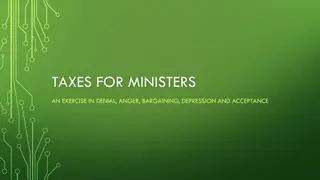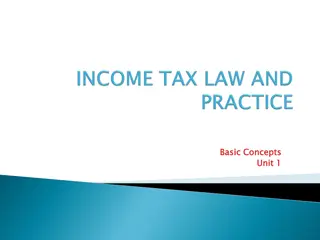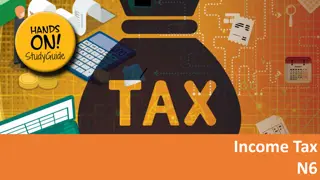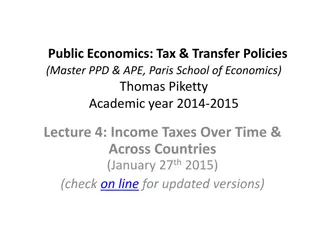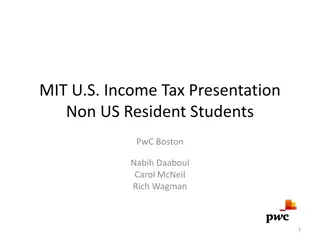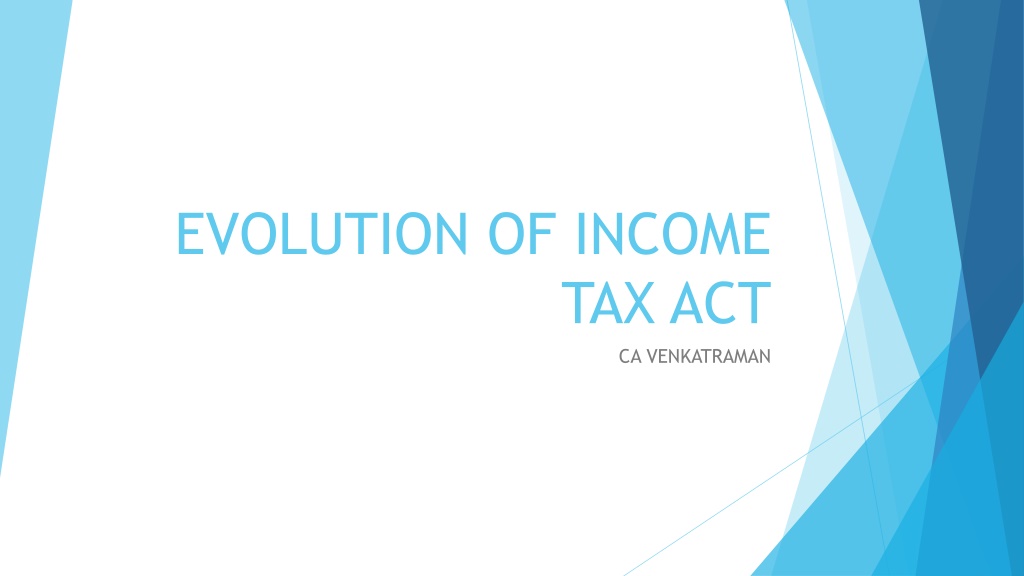
Evolution of Income Tax Act in India
Explore the historical evolution of income tax in India from ancient times to the medieval and Mughal eras, highlighting the various taxes imposed and their impact on society and governance. Delve into the roots of the present tax system and understand the significance of taxation in shaping economic structures.
Download Presentation

Please find below an Image/Link to download the presentation.
The content on the website is provided AS IS for your information and personal use only. It may not be sold, licensed, or shared on other websites without obtaining consent from the author. If you encounter any issues during the download, it is possible that the publisher has removed the file from their server.
You are allowed to download the files provided on this website for personal or commercial use, subject to the condition that they are used lawfully. All files are the property of their respective owners.
The content on the website is provided AS IS for your information and personal use only. It may not be sold, licensed, or shared on other websites without obtaining consent from the author.
E N D
Presentation Transcript
EVOLUTION OF INCOME TAX ACT CA VENKATRAMAN
Introduction Tax is a mandatory liability Taxes divided into direct tax and indirect tax The roots of present tax system is derived from Manu Smrithi & Artha Sastra Ancient tax system is based on Maximum Social Welfare The word Tax originated from the word Taxation . It means estimate. A reference is made to Latin word Taxare / taxo which refers to assess the worth of something. Formal tax system was first found in India during Mauryan Empire around 300 B.C. In general, higher class citizens contributed 1/6thof their income as tax.
Puraanik reference MANUSMRITHI: (7.127) King to draw taxes as like how leech, calf, and bee take their food little by little KALIDASA in RAGHUVAMSA: It was only for the good of his subjects that he collected taxes from them, just as the Sun draws moisture from the Earth to give it back a thousand-fold
Puraanik reference ARTHA SHASTHRA: (300 to 230 B.C.) From the treasury, comes the power of the government, and the Earth whose ornament is the treasury, is acquired by means of the Treasury and Army Taxes are the earning of government for the services to the people, to protect them and to maintain law and order; Govt. require huge revenue: to manage and run its administration, spend money on essential public services such as health and education and infrastructure such as roads, railways etc. It provides not only system of tax but also rates to be charged for different items It speaks about, tax, octroi duties, tolls and custom duties. It is an option given to people and taxes not levied on people.
Puraanik reference RAMAYANA: MAHABHARATHA:
History of tax in India Different taxes were imposed during Gupta Era: Kalpita / Upkalpita Sales Tax Halivakar / Halidanda Tax on cultivation Prataya Toll tax Bhog Kings share in agri produce Bhatta Police tax Medieval India Kharaj Land revenue (Major income source for Sultanate period) Initially 1/5thshare in total produce levied and made to by Ala-ud-din Khilji & Muhammad Thuglak Jazia Tax levied on non-muslims
History of tax in India Octroi Duty Exchange and transportation including imports Zakat Tax levied on muslims. Ghari tax Tax on house Chari tax Tax on pastures. Mughal Era: Todarmal Bandobast Tax based on average produce of past 10 years Batai Tax paid in the form of crops Bhaoli Crops stored in place and divided Khet Bhatai Land divided and cultivation from it is taken Lang Bhatai Grains yielded from crops are shared
History of tax in India Marathas Chauth Military contribution of 1/4thof place invaded by Marathas. Sardeshmukhi Additional 10% tax collected by central administration British Rule Zamindari System Introduced through the Permanent Settlement Act, 1793 in which ownership of lands were transferred to Zamindars who were authorized to collect taxes and pay to British Ryotwari System Developed by Thomas Munro in 1820 in South India Mahalwari System Holt Mackenzie introduced this system in 1822 in regions Central Province, North-West Frontier, Agra and Punjab.
Tax revolutions in Globe Tax Reforms in England (16th 17th Century): Tudor and Stuart monarchs intensified taxation through the enactment of excise taxes and customs duties. The Bill of Rights (1689) established legislative oversight of taxation following the Glorious Revolution (1688). The American Revolution of 1776: American colonists protested against British taxes, such as the Stamp Act (1765) and the Tea Act (1773), giving rise to the famous slogan No taxation without representation. The U.S. Constitution (1787) empowered Congress to establish federal tax laws. The French Revolution (1789): Public outrage due to the heavy taxation imposed on the impoverished under the Ancient R gime led to the creation of a fairer and simpler tax framework by the new government.
Around the Globe Country Year of Introduction of Income Tax U.S.A 1913. U.K. 1842 Germany 1893 Australia 1915
History of Income Tax in India First introduced in February 1860 by James Wilson (India s first finance minister under British Rule) It was 1stintroduced to compensate losses sustained during 1857 rebellion. It consisted of 259 section and income was classified as below: Income from landed property; Income from professions and trade; Income from securities, annuities and dividends; Income from salaries and pensions.
History of Income Tax in India Tax rate was 2% for income between 200 to 499 and 4% for higher income First financial year commenced on 1stAugust 1860. Other taxes levied were Customs tax and Salt tax. Lord Rippon brought urban local body taxes namely Municipal taxes
Evolution of Income Tax Act In 1886 a separate income tax Act was enacted with heads of income as : (1) Salaries, pensions or gratuities; (2) Net profits of companies; (3) Interests on the securities of the Government of India; (4) Other sources of income. 1886 Act as repealed and a new Income tax Act was passed in 1918. Within 4 years a new Income tax Act was passed in 1922. Income tax department was brought into by this Act. Nomenclature of various authorities under income was given under this law Innumerable amendments were made to this Act.
Present Income tax Act In 1956, the Government after looking into the complexities of existing Act (1922 Act) set up a Law Commission to draft a new income tax law. After consultation with Ministry of Law, new Income Tax Act ,1961 was passed. It came into force effective from 1stApril 1962. This Act had 298 sections comprised into 23 Chapters and Fourteen Schedules The heads of income under this Act was: (1) Income from Salary; (2) Income from House Property; (3) Income from Profits and Gains of Business or Profession; (4) Income from Capital Gains; (5) Income from Other Sources.
THANK YOU venkatramank@ca.mail.in +91 96772 61006





